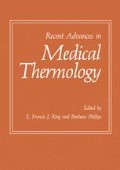Abstract
The temperature of the human body has been widely used as an index of illness since antiquity. The hand of an experienced physician laid upon the skin could provide much useful information about the temperature of a patient and the course of an illness. Eventually, more objective assessment was possible and the clinical thermometer (much as we know it today) was developed during the last century. This instrument rapidly became firmly established as this extract from a work of 1882 shows — “It (the thermometer) is now in daily, nay hourly, use in every hospital in London, and ranks in importance with the stethoscope. A doctor without his thermometer is like a sailor without his compass”.1
Access this chapter
Tax calculation will be finalised at checkout
Purchases are for personal use only
Preview
Unable to display preview. Download preview PDF.
References
in: “Family Physician,” By physicians and surgeons of the principal London hospitals, Cassel, Petter, Galpin and Co. (1882).
D. McK. Kerslake, in: “The stress of hot environments,” Monograph of the Physiological Society No. 29, Cambridge University Press (1972).
Y. Houdas, and E. F. J. Ring, “Human Body Temperature. Its Measurement and Regulation,” Plenum Publishing Corporation, (1982).
M. Nielsen, Die regulation der Karper temperatur bi Muskelarbeit, Scand. Arch. Physiol. 79: 193–230 (1938).
R. P. Clark, Human skin temperature and convective heat loss in: “Bioengineering, Thermal Physiology and Comfort,” K. Cena and J. A. Clark ed., Elsevier Scientific Publishing Co., (1981).
W. M. Park, and B. L. Reece, Fundamental aspects of medical thermography. British Institute of Radiology–Teaching Booklet No. 3. ISSN 0306–8862 (1976).
R. P. Clark, and J. K. Stothers, Neonatal skin temperature distribution using infrared color thermography, J. Physiol. 302: 323–333 (1980).
R. P. Clark, M. R. Goff and J. S. Garrow, Poster presentation at International Conference on the adipocyte and obesity; cellular and molecular mechanisms. June, 1982. Toronto University. In Press.
R. P. Clark, B. J. Mullan, and L. G. C. E. Pugh, Skin temperatures during running–a study using infrared color thermography, J. Physiol 267: 1: 53–62 (1977).
R. P. Clark, M. R. Goff and B. J. Mullan, Skin temperatures during sunbathing and some observations on the effect of hot and cold drinks on these temperatures, J. Physiol. 267: 1: 8–9 (1977).
R. P. Clark, The effect of hot and cold drinks on skin surface temperature distributions, Proceedings of the IXth International Colloquium on Coffee–London. June 16–20. Vol. 11, p. 405–411 (1980).
R. H. Fox and S. M. Hilton Bradykinin formation in human skin as a factor in heat vasodilatation, J. Physiol. 142: 219–232 (1958).
R. H. Fox, R. Goldsmith and D. J. K d The cutaneous vasomotor control in the human nose, lip and chin, J. Physiol. 150:22–23 (1960).
R. P. Clark and M. R. Goff, Human skin temperature during rest and sleep visualized with color infrared thermography, J. Physiol. 300: 14–15 (1979).
E. F. J. Ring, Computerized thermography for osteo-articular diseases, Acta Thermographica 1: 166 (1976).
R. P. Clark, M. R. Goff and J. K. Stothers, Microprocessor image analysis of neonatal thermograms, J. Physiol. 352: 4 (1982).
Author information
Authors and Affiliations
Editor information
Editors and Affiliations
Rights and permissions
Copyright information
© 1984 Plenum Press, New York
About this chapter
Cite this chapter
Clark, R.P. (1984). Human Skin Temperature and Its Relevance in Physiology and Clinical Assessment. In: Ring, E.F.J., Phillips, B. (eds) Recent Advances in Medical Thermology. Springer, Boston, MA. https://doi.org/10.1007/978-1-4684-7697-2_2
Download citation
DOI: https://doi.org/10.1007/978-1-4684-7697-2_2
Publisher Name: Springer, Boston, MA
Print ISBN: 978-1-4684-7699-6
Online ISBN: 978-1-4684-7697-2
eBook Packages: Springer Book Archive

